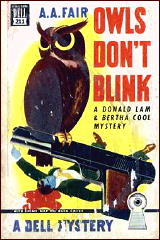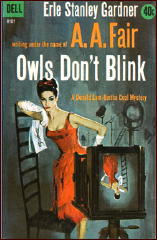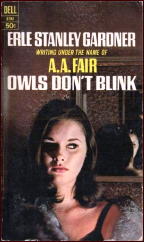Tue 18 Aug 2009
A 1001 MIDNIGHTS review: A. A. FAIR – Owls Don’t Blink.
Posted by Steve under 1001 Midnights , Reviews[11] Comments
by Marcia Muller:
A. A. FAIR – Owls Don’t Blink. New York: William Morrow, hardcover, 1942. Paperback reprint: Dell 211, mapback, 1948. Many other reprint editions in both hardcover and soft.

A. A. Fair is a pseudonym of Erle Stanley Gardner, but don’t pick up one of these novels featuring private eyes Bertha Cool and Donald Lam expecting a couple of carbon copies of Paul Drake.
Cool and Lam are an amusing and endearing pair — perfect foils for one another. Bertha Cool, at the time of this novel, is the middle-aged proprietor of an L.A. investigative firm, pared down to a mere 165 pounds but ever on the alert for a good meal. Her partner, Donald Lam, is a twerp in comparison — young, slender, and forever on the defensive for what Bertha considers excessive squandering of agency money.
But there’s considerable affection between the two, and with Donald doing the legwork, they crack some tough cases — and have a lot of fun while doing so.

Owls Don’t Blink opens in the French Quarter of New Orleans, where Donald is occupying an apartment once rented by a missing woman he has been hired to find. He is due to meet Bertha at the airport at 7:20 the next morning and knows there will be hell to pay if he’s late.
Fortunately, he arrives on time, and together they meet the New York lawyer who has hired them to find Roberta Fenn, a former model. Over a number of pecan waffles — a number for Bertha, that is, who “only eats once a day” — the lawyer is evasive about why he wishes to locate Miss Fenn. But Cool and Lam proceed with the case — and Bertha proceeds with several lavish meals, still on that same day.
The discovery of the missing woman’s whereabouts proves all too easy, and also too easy is the discovery of a corpse in Roberta Fenn’ s new apartment. But from there on out, everything’s as convoluted as in the best of the Perry Mason novels.

The scene moves from New Orleans to Shreveport, Louisiana, and from there to Los Angeles, where its surprising (although possibly a little out-of-leftfield) conclusion takes place.
And there’s a nice twist in the Cool-Lam relationship that will make a reader want to read the later entries in this fine series, such as Crows Can’t Count (1946), Some Slips Don’t Show (1957), Fish or Cut Bait (1963), and All Grass Isn’t Green (1970). Especially entertaining earlier titles are The Bigger They Come (1939) and Spill the Jackpot (1941).
———
Reprinted with permission from 1001 Midnights, edited by Bill Pronzini & Marcia Muller and published by The Battered Silicon Dispatch Box, 2007. Copyright © 1986, 2007 by the Pronzini-Muller Family Trust.
August 18th, 2009 at 12:47 pm
Interesting to find this post today, as i just finished a Lam and Cool yesterday — Widows Wears Weeds. It’s a later entry in the series. These books are terrific. The banter between Cool and Lam is worth the price of admission. The plots can be a bit complicated (overly complicated), but the characters are terrific fun.
August 18th, 2009 at 1:12 pm
Frank
I haven’t read one of the Lam & Cool books since KEPT WOMEN CAN’T QUIT, which I reviewed in the post just before this one, and I’m amazed to see that that was six years ago.
I’m willing to bet that nobody can read several of A.A.Fair’s books in a row, or even in close proximity, but I’d have to say that I’m spreading them out way too much. Right now I have the itch to read another one, and soon. The urge is just not going away!
— Steve
August 18th, 2009 at 10:26 pm
Steve
I would argue that you wouldn’t want to read too many in a row by many mystery writers who do series. I know I have read halfway through a Maigret once or twice before realizing I had read it before.
I think it is just the nature of series fiction. I can think of exceptions, but in general its still a trusim.
September 21st, 2009 at 5:13 pm
Au contraire!
I recently discovered this series, and I’m on a tear, going through each one of them in turn. I started with Fish or Cut Bait, and Some Women Won’t Wait, and Crows Can’t Count, before deciding to back up to the beginning and go in order. I’ve tackled The Bigger They Come, Turn On the Heat, Gold Comes In Bricks, Spill the Jackpot, Double or Quits, and now I’ve just finished Owls Don’t Blink (which I think is the most apt title so far).
By the way, I was so disappointed when Turn On the Heat didn’t explain how Donald made it back to California after that extradition trick at the end of The Bigger They Come. Anyone have any clue? Was it ever mentioned again?
September 21st, 2009 at 7:40 pm
Alan
It’s a good thing I wasn’t betting real money!
— Steve
September 21st, 2009 at 10:13 pm
If I remember there is a brief mention in the second or third book, only a sentence or two, that once the real killer was revealed Donald was free to come back, or something along those lines — though I can’t imagine he was very popular with the Prosecutor or Attorney General. We can assume Bertha pulled some strings, hired a good lawyer (Perry Mason perhaps or at least Terry Cline), and bullied Donald out of trouble. I really don’t think Gardner devoted more than two sentences to the whole thing. And I grant, having read these particular book last in 1969 I may have imagined the whole thing to ease my own problem with the first books ending.
Still, I think I’m right, since Gardner seems to have intended Lam and Cool to be a series and I can’t imagine him not having an out, even it was the equivalent of the famous cliffhanger in Captain America where Dick Purcell falls down a mine shaft and then in the next episode just lands on his feet and walks away.
Gardner always claimed that the gimmick was legitimate, and the legislature passed a midnight bill to correct the problem. Whether that is true or not is up to someone more familiar with California law and it’s history than I am.
I have enough trouble with Texas and Oklahoma laws. For instance there is a provision in the Texas Constitution forbidding a man who has been dead over 100 years from buying any more land.
As Dickens pointed out sometimes “the law is a ass.”
October 5th, 2009 at 4:51 pm
Dave,
Thanks for that answer. I suspect you’re right, because it just seems as if Gardner wouldn’t have left that important point unresolved.
I must have just missed it. It’s strange, though, because I read Turn on the Heat consciously trying to look out for that info. Maybe I’ll try reading it again.
October 6th, 2012 at 8:45 pm
Sorry for being so late to this party.
Donald can easily return to California, at the end of The Bigger They Come, because, as Bertha Cool explains to Donald Lam in his Phoenix hotel, the bad guy: “wilted like a hot lettuce leaf. If he beats the rap on the Morgan Birks murder they’re going after him on the Kansas City kill.â€
October 6th, 2012 at 9:18 pm
Deadman
Thanks for the assist. Good to have the question answered!
October 16th, 2019 at 9:46 am
There was a second Dell mapback of Owls Don’t Blink published as No. 243 – just 32 numbers subsequent to 211. LibraryThing has a cover picture.
October 16th, 2019 at 10:23 am
Thanks, Gary. I couldn’t find my way around the LibraryThing site, but I did come up with this page:
http://bookscans.com/Publishers/dell/dell05.htm